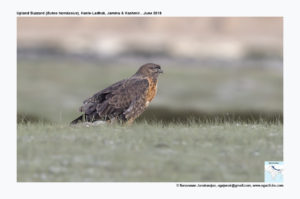Upland Buzzard

Upland Buzzard Buteo hemilasius
Etymology:
- Buteo : Latin word for Buzzard
- Hemilasius : Greek word hemi- half, small ; lasios- hairy.
Vernacular Names: Hindi: Chuhamar, Pun: Pahari tisa, Guj: Himalaya teeso, Moto tiso
Distribution in India: Breeds in Ladhak and winters in Himalayas.
Description: Size of 66–71 cm; wt. of male 950–1400 g, female 970–2050 g; wingspan of 143–161 cm. It has a white primary patch on upper wing, greyish-white tail and whitish head. Underparts have dark brown streaking, brown thighs and extensive black carpal patches. Both sexes similar, female is bigger than male. The pale-morph juvenile is brown above with pale feather edges, head white or pale, spotted brown; the dark juvenile resembles dark-morph adult.
Habitat: It is found in open, normally dry, grassy areas and grassy mountain slopes, with rocky areas for nesting. Mainly recorded at 1000–4500 m in nesting season and down to sea-level in winters
Food Habits: It eats mainly rodents like ground squirrels, voles, gerbils, picas and young marmots, but also young hares; to lesser degree small terrestrial birds such as larks and pipits and sometimes larger birds like Tibetan Snowcock, birds’ eggs, amphibians, and large insects like beetles, grasshoppers. Hunts prey from surveying flight or after spotting it from perch or a rock, sometimes catches insects on ground fire
Breeding Habits: They breed in April-Aug. Nests on ledges in rock faces, preferably protected by overhang or by vegetation, and occasionally on steep grassy slopes; nest built with sticks and lined with wool, grass, dry dung and other material. Normally 2–4 eggs in a clutch, incubation is for 35–38 days; chicks have greyish-brown down feathers and fledge in 45 days.